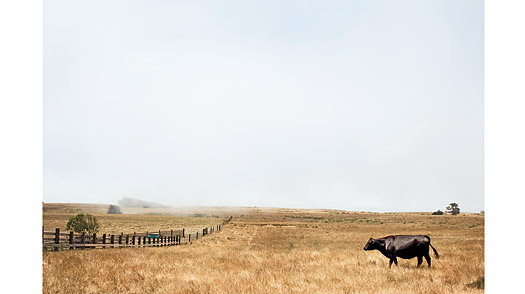
One of more than 100 cattle on Bill Niman's California property, home of an ongoing experiment in sustainable ranching.
(5 of 8)
If a factory farm is hell for an animal, then Bill Niman's seaside ranch in Bolinas, Calif., an hour north of San Francisco, must be heaven. The property's cliffside view over the Pacific Ocean is worth millions, but the black Angus cattle that Niman and his wife Nicolette Hahn Niman raise keep their eyes on the ground, chewing contentedly on the pasture. Grass--and a trail of hay that Niman spreads from his truck periodically--is all the animals will eat during the nearly three years they'll spend on the ranch. That all-natural, noncorn diet--along with the intensive, individual care that the Nimans provide their animals--produces beef that many connoisseurs consider to be among the best in the world. But for Niman, there is more at stake than just a good steak. He believes that his way of raising farm animals--in the open air, with no chemicals or drugs and with maximum care--is the only truly sustainable method and could be a model for a better food system. "What we need in this country is a completely different way of raising animals for food," says Hahn Niman, a former attorney for the environmental group Earthjustice. "This needs to be done in the right way."
The Nimans like to call what they do "beyond organic," and there are some signs that consumers are beginning to catch up. This November, California voters approved a ballot proposition that guarantees farm animals enough space to lie down, stand up and turn around. Worldwide, organic food--a sometimes slippery term but on the whole a practice more sustainable than conventional food--is worth more than $46 billion. That's still a small slice of the overall food pie, but it's growing, even in a global recession. "There is more pent-up demand for organic than there is production," says Bill Wolf, a co-founder of the organic-food consultancy Wolf DiMatteo and Associates.
So what will it take for sustainable food production to spread? It's clear that scaling up must begin with a sort of scaling down--a distributed system of many local or regional food producers as opposed to just a few massive ones. Since 1935, consolidation and industrialization have seen the number of U.S. farms decline from 6.8 million to fewer than 2 million--with the average farmer now feeding 129 Americans, compared with 19 people in 1940.
It's that very efficiency that's led to the problems and is in turn spurring a backlash, reflected not just in the growth of farmers' markets or the growing involvement of big corporations in organics but also in the local-food movement, in which restaurants and large catering services buy from suppliers in their areas, thereby improving freshness, supporting small-scale agriculture and reducing the so-called food miles between field and plate. That in turn slashes transportation costs and reduces the industry's carbon footprint.
